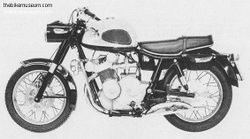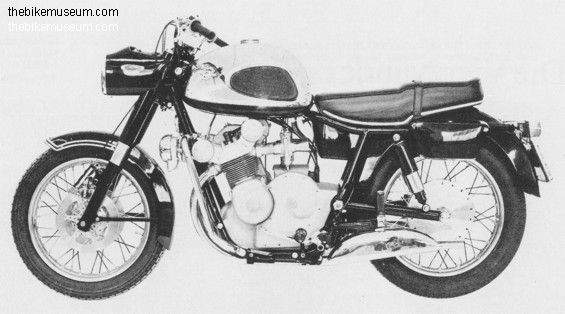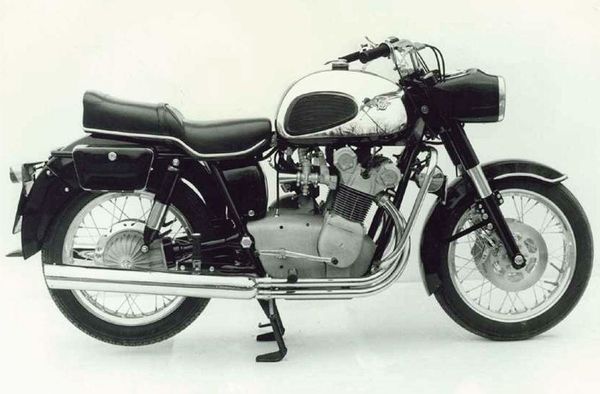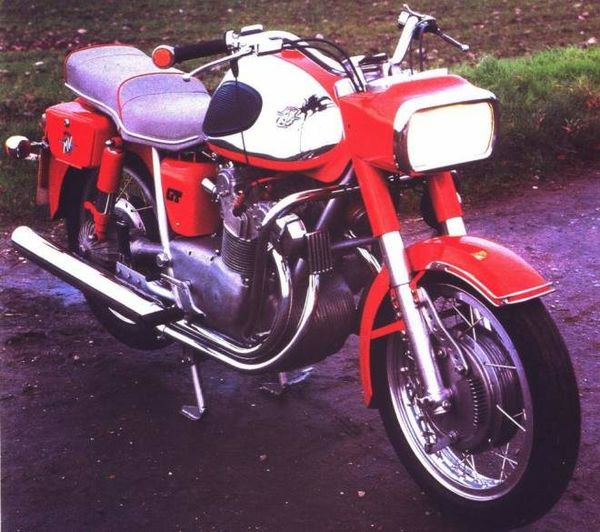MV Agusta 600 Turismo 4C6
 |
|
| MV Agusta 600 Turismo 4C6 | |
| Manufacturer | |
|---|---|
| Production | 1966 |
| Engine | Four stroke, transverse four cylinder, DOHC, 2 valve per cylinder |
| Compression ratio | 9.3:1 |
| Ignition | Battery and coil |
| Transmission | 5 Speed |
| Frame | Double cradle tubular steel |
| Suspension | Front: Telescopic hydraulic forks Rear: Swinging arm with hydraulic shocks |
| Brakes | Front: 2x 203mm discs Rear: 200mm Drum |
| Front Tire | 3.50-18 |
| Rear Tire | 4.00-18 |
| Wheelbase | 1390 mm / 54.7 in |
| Weight | |
| Fuel Capacity | 24 Liters / 6.3 US gal |
| Manuals | Service Manual |
Engine[edit | edit source]
The engine was a Air cooled cooled Four stroke, transverse four cylinder, DOHC, 2 valve per cylinder. The engine featured a 9.3:1 compression ratio.
Drive[edit | edit source]
Power was moderated via the Wet multiple plate clutch.
Chassis[edit | edit source]
It came with a 3.50-18 front tire and a 4.00-18 rear tire. Stopping was achieved via 2x 203mm discs in the front and a 200mm Drum in the rear. The front suspension was a Telescopic hydraulic forks while the rear was equipped with a Swinging arm with hydraulic shocks. The 600 Turismo 4C6 was fitted with a 24 Liters / 6.3 US gal fuel tank. The wheelbase was 1390 mm / 54.7 in long.
Photos[edit | edit source]
Overview[edit | edit source]
MV Agusta 600 Turismo 4C6
Asmooth rustling whistle, ihe quick tearing of thick silk, announces arrival of Count Domcnico Agusta's 600-cc Four. This fascinating sound, an exciting whisper-pitched portent of power, comes as a surprise to those who recall the thunderous MV Agusta machines of the Grand Prix circuit, the championship roadburncrs of Hailwood. Agostini and Surtccs. The MV Agusta 600 Four is not a piece of high-strung racing machinery; it is a smoothly engineered, smoothly finished motorcycle expressly for the road. The good Count's racing Super/Fours arc the brutish forebears of the 60O's powcrplant. but in this machine the excessively peaky performance of the competition motorcycles has been replaced by broader, mid-range rpm flexibility that makes this MV perhaps the premier roadster of the world. This statement is bold, indeed, but it is not made without careful consideration and a great deal of very pleasurable riding. In addition to that sound, first sight of the MV Four is impressive. Double disc brakes and massive rectangular headlight forward, hat-shaped ring and pinion gear housing at the rear, and the broad, humped fuel tank and formidable engine in between present a truly massive appearance. Yet. sheer size is not present for the sake of size, as it is with some American automobiles, for example.
The bulk of the MV Four is functional. What needs to be big is big. Astride the MV. however, much of that awesome largeness falls away. The short-legged rider finds the soft saddle positioned at such low altitude that even his feet arc flat on the ground when the bike is at rest. The long of arm and leg discover that footpegs. handlebars and control levers arc in equitable positions. Both long and short agree the MV is very close to universal comfort in a motorcycle. Once rolling, the last trace of massive demeanor disappears completely. The air cooled four-cylinder engine, turbine smooth, is responsive from fast idle (after a 2- to 3-min. warm-up period) to full throttle. In the lower gears, the Four quickly achieves maximum rpm and gears must be changed up quickly. Though gear spacing is excellent through the five speeds, wider ratios could have been employed, so wide is the MV Four's useful power band. Clutch lever and gear change mechanism work together in smooth accord. If the engine is to be faulted in any respect, it is for lack of flywheel effect. Test riders were forced to maintain an inordinate idle rpm when stopped for traffic lights. Even lacking marked flywheel action, however, the Four delivers adequate getaway power without undue clutch slippage or overly high rpm. Technically sneaking, the powcrpJant is of double overhead camshaft design. The intake and exhaust camshafts both are driven through a gear tower located between No. 2 and No. 3 cylinders of the Four. This particular engine layout is best known for minimization of reciprocating valve train inertia, and for free breathing, as pushrods do not protrude into the intake or exhaust gas streams. Thus, the MV engine's designers weren't forced into parsimony for intake and exhaust port area. The ohc layout, with its straight-cut drive gears, numerous bearings, and lobe-to-stcm cam contact areas, contributes that which is perhaps the MV's outstanding characteristic the beautiful sound. The valve equipment's audibility is directly attributable to the quietness of the remainder of the MVs power train. The primary gear drive (oil pump and distributor drives, too) also is between the middle cylinders. The constant mesh five-speed transmission delivers power, through the multiple-disc clutch, to a geared, slip-splined cardan shaft which turns the pinion gear, which turns the final drive ring gear.
The drive shaft housing is employed as the right-hand swinging arm. The MV's shaft drive system showed no slack, or general jerky looseness, nor the characteristic sounds of chain drive motorcycles. Indeed. the shaft drive was one of the major contributors to the MVs overall quality of smoothness. A pair of 24-mm Dellorto carburetors, each fitted to a U-shaped manifold, serve the left and right pairs of cylinders. The test machine's induction system was not fitted with any sort of air filtration device. Rather, conical velocity pipes adorned the carburetor inlet orifices. Lack of filtered air may be well and good in a region where streets and highways arc regularly washed with rain, but filtration seems mandatory in areas where abrasive dust is an ever-present fact of life in the western U. S.. for example. Ample spuce is available under the MV's fuel tank or split level saddle for an air filler cannister. The Count's designers could well busy themselves in readying such a device for export models of the MV Agusta 600 Four. True, restriction of intake air would reduce power output of the Four. But what is I bhp of 50 when a magnificent and expensive Italian engine can be prevented from grinding itself to usclcssncss with ingested grit? " The MV Four's electricals functioned without fail with one major exception. The battery (rated at 12 V. 18 ampere/hours) simply wasn't up to the task of spinning the 9.3:1 compression ratio four-cylinder engine while at the same time supplying electric spark required for ignition and sustained combustion.
Frustrated is a less than adequate word to describe the feelings of those who were forced to bump-start the hefty tourer so carefully designed and equipped for effortless electrical pushbutton starting. A U. S.-made light aircraft battery would prove a replacement of adequate power output and suitable size. The MV's 12-V. I35-W generator (which doubles as starter) proved adequate to meet demands of the 45-W A A headlamp and the 25-W power requirement of tail and brake lights. The headlamp the shape of which is prohibited in some unenlightened states among the 50 provided a broad swath of brilliant illumination for nighttime operations. The roadable motorcycle, the machine thai is to be driven at lop legal speeds wherever it goes, musi be equipped with mean* to decelerate at the rider's chosen rate, or slop smoothly, without incident, should the all-on panic situation arise. The MV's double-disc front and drum rear system accomplishes cither chore wilh case. The smoothness of the MV Four carries over into its braking equipment. Slowing for a bend is simply a gradual, lightly increasing pressure on fool and hand braking levers accompanied by effortless downshifts.
A full stop simply is greater lever pressure exerted more quickly wilh care headlamp and the 25-W power requirement of tail and brake lights. The headlamp the shape of which is prohibited in some unenlightened states among the 50 provided a broad swath of brilliant illumination for nighttime operations. The roadable motorcycle, the machine thai is to be driven at lop legal speeds wherever it goes, musi be equipped with mean* to decelerate at the rider's chosen rate, or slop smoothly, without incident, should the all-on panic situation arise. The MV's double-disc front and drum rear system accomplishes cither chore wilh case. The smoothness of the MV Four carries over into its braking equipment. Slowing for a bend is simply a gradual, lightly increasing pressure on fool and hand braking levers accompanied by effortless downshifts. A full stop simply is greater lever pressure exerted more quickly wilh care Source Cycle World 1968
| Make Model | MV Agusta 600 Turismo 4C6 |
|---|---|
| Year | 1966 |
| Engine Type | Four stroke, transverse four cylinder, DOHC, 2 valve per cylinder |
| Displacement | 591.5 cc / |
| Bore X Stroke | 58.0 x 56 mm |
| Cooling System | Air cooled |
| Compression | 9.3:1 |
| Lubrication | Wet sump |
| Induction | 2 x 24mm Dellorto MB 24 carburetor |
| Ignition | Battery and coil |
| Starting | Electric |
| Max Power | 37 kW / 49.6 hp @ 8200 rpm |
| Clutch | Wet multiple plate clutch |
| Transmission | 5 Speed |
| Final Drive | Shaft |
| Frame | Double cradle tubular steel |
| Front Suspension | Telescopic hydraulic forks |
| Rear Suspension | Swinging arm with hydraulic shocks |
| Front Brakes | 2x 203mm discs |
| Rear Brakes | 200mm Drum |
| Front Tire | 3.50-18 |
| Rear Tire | 4.00-18 |
| Dimensions | Length: 2210 mm / 87.0 in Width: 620 mm / 24.4 in |
| Wheelbase | 1390 mm / 54.7 in |
| Weight | 221 Kg / 487 lbs |
| Fuel Capacity | 24 Liters / 6.3 US gal |
| Reviews | Streetbike / Classic Motorcycle / Cycle World / Classic Motorcycle / The Classic MotorCycle / Cycle / Moto Legende |
External Links[edit | edit source]
- http://thebikemuseum.com/master_docs.php?id=138
- http://thebikemuseum.com/master_docs.php?id=136
- http://thebikemuseum.com/master_docs.php?id=12
- http://thebikemuseum.com/master_docs.php?id=34
- http://thebikemuseum.com/master_docs.php?id=13
- http://thebikemuseum.com/master_docs.php?id=40
- http://thebikemuseum.com/master_docs.php?id=3


